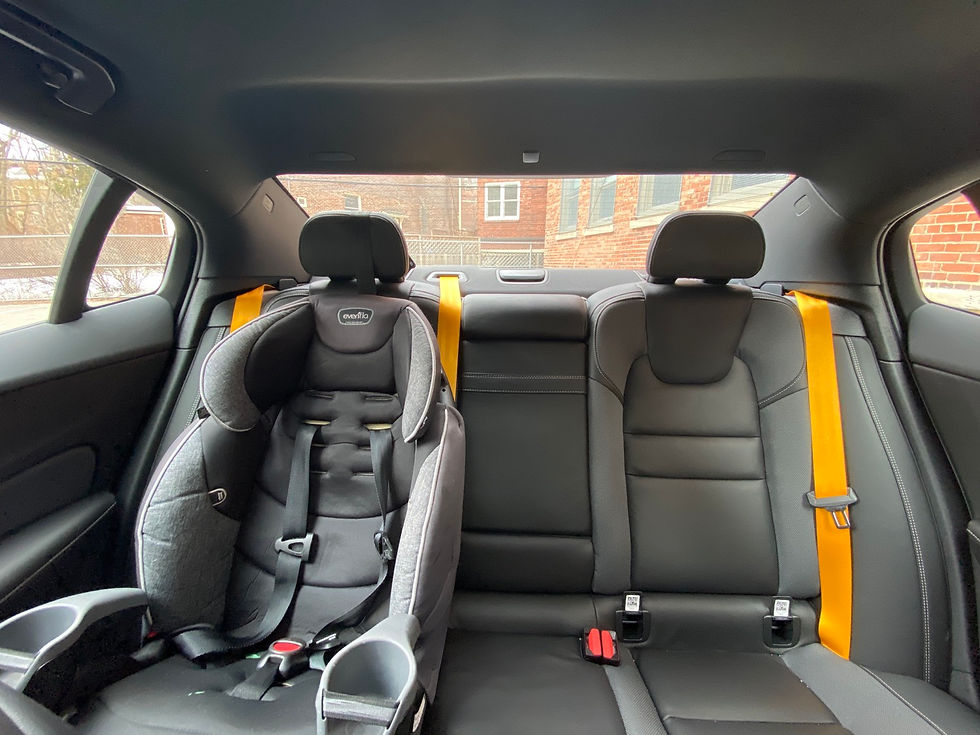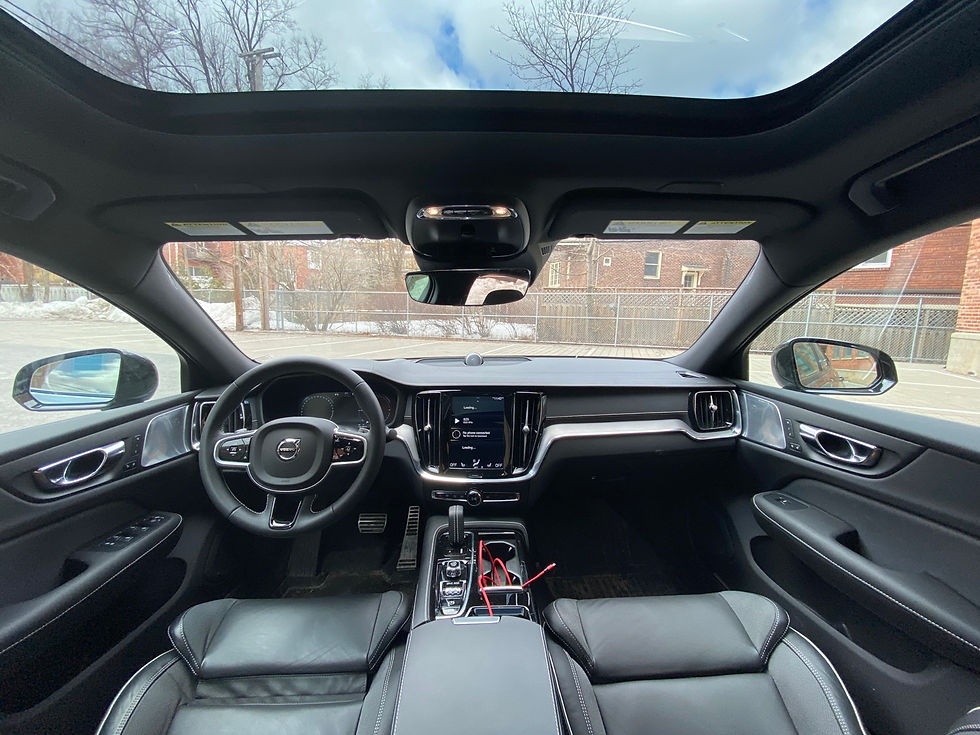2020 Volvo S60 Polestar Engineered
- Alain Kuhn Von Kuhnenfeld
- Apr 21, 2020
- 7 min read
Updated: Apr 27, 2020
This week we are reviewing the Volvo S60 Polestar Engineered. Our vehicle was assembled at the Ridgeville plant in South Carolina and has an MSRP of $83965.00 CAD.

Fun Factor: 9
Can it Family: 7
Fuel-Friendly: 8
HWY-warrior: 8
Karaoke-Friendly: 10
Baby-Friendly: 7
City Cruising: 9

How can Volvo make the S60 T8 even better? Naturally, by giving it over to the Polestar team to enhance its performances and handling. The Standard S60 T8 Twin Engine produces 400hp and 472 lb-ft. of torque from a 2L in-line 4-cylinder that is both supercharged, turbocharged and is also being pushed by an electric engine that propels rear wheels. While the Polestar Engineered produces an additional 15hp and 22 lb-ft. of torque to bring these figures to 415hp and 494 lb-ft. of torque, respectively. The upgrades are not just performance-oriented; they improved the stopping distance using Brembo brakes. Those callipers have an additional flair as they are painted in "Swedish Gold," showing people that your S60 is something out of the ordinary. This is complemented by the upgraded Öhlins shock absorbers that have dual-flow valves for both the front and rear multi-link suspension; this allows for stiffer springs and dampeners and at the same time retaining the comfort we are used to from Volvo. Additionally, these can be tweaked to provide a firmer or softer ride.
In our real-life acceleration test, we achieved 0-100km/h in a respectable 5.95 seconds using winter tires. Volvo says the S60 T8 can achieve this figure in 4.9 seconds from a stillstand. While these figures aren't impressive for a vehicle in its price range, our take is that the whole system may require some additional tuning to really take advantage of all the power. The acceleration seems to stumble when the electric engine produces its maximum power, and when the engine switches from the supercharger to the turbocharger, it upsets the momentum of the vehicle. The imbalance of performance causes the vehicle to get torque steer as the front engine is a lot more powerful than the electric engine pushing the rear wheels. We imagine that if the electric motor that pushes the rear wheels would get a boost in power, then the issue can be counterbalanced. You will notice this, in particular, when flooring it. In the day-to-day, this sensation is a lot less apparent, especially when commuting to work. Around corners, we felt that the S60 Polestar Engineered was a lot more agile; this is mainly due to its EV engine and additional battery weight giving it a better weight distribution. The additional length compared to the previous generation of S60 gives it better stability, something that we had pointed out when we tested the S60 R-Design. The S60 is no small car anymore; it's only 3 inches shorter than the S80 from 4 years ago.

The interior space feels spacious for a vehicle in this segment; it's enhanced with little accents such as the golden seat belts, the contrasting topstitching, and general finishes making it more interesting and keeping with its Swedish roots. The rear seats may accommodate 3 adults; the middle seat is wider than what you often find and doesn't have an unpractical bump; therefore, it can accommodate someone that is 5ft7 or less. Volvo has some of our favourite seats in the industry, and we would be more than happy to take place in the back during road trips. Those outer rear seats offer heated seats, which heat up quite quickly and are probably some of the warmest we've tested. The front seats are also heated, the same goes for the steering wheel, it was so toasty that on several occasions we had to turn it off. Now moving to the trunk, a lot of plugin hybrid lose some the trunk space this isn't the case with the S60, we were able to fit the same large stroller as in the regular S60. The rear seats can be lowered electronically from the trunk; they split 60/40. Once lowered, there is a little hump between the trunk and the cabin, which makes it more challenging to enter longer items. If you do require a flat floor, Volvo does offer the V60 as a Plugin Hybrid too.

During our test, we averaged 5.6L per 100km over a distance of 550km. We were able to get fuel consumption as low as 2.9L per 100km in the city. On the HWY, you can expect a fuel economy of about 7.2L per 100km. The advertised electric range is 35km; however, most days, we only reached 24 km. Temperature, which oscillated between +9 and -7, played a major factor in not being able to reach a greater distance, but we figured it could do better. Our morning commute is exactly 25km one way; hence we should have been able to get to work without using any fuel. Most days, the engine would kick in after 24 km, when we switched from Hybrid mode to Pure mode we were able to spare 3km of range, giving us a total range of 28km. We decided to test the EV range and have everything on our side this time; we left the vehicle in Pure mode and turned off the climate controls; as a result, we were able to drive 47km. From our experience, we note that outside temperatures affect the EV range more than what we have seen on other PHEVs. Naturally, like all other PHEV or Ev's, using less of your climate controls helps you reduce your fuel consumption and emissions. The level of emissions is also a strong point of the Volvo S60 T8 having similar smog and Co2 rating as the Toyota Prius Prime with Natural Resources Canada. The Fuel economy Volvo announces a combined 3.2Le per 100 km without the hybrid system, the fuel economy for the S60 in the city 8.4 per 100km, HWY 7.0 per 100km, combined 7.8L per 100 km.

Safety has always been a forte for Volvo with features such as impact protection, lane mitigation, whiplash injury protection system, with the aim that in case of an accident, passengers would be able to walk away with minimal injuries. Many security features come standard, such as Pilot Assist, a semi-autonomous system that supplements the adaptive cruise control. This system facilitates driving in stop and go traffic and assist while driving on the HWY; it's not a hands-off driving tool; instead, it gives you an additional layer of security and takes advantage of the hybrid system to maximize fuel efficiency. An enhancement we would like to see added to the Sensus system and GPS would be to adjust the best mode automatically depending on the route driven. Several PHEVs already offer this feature and will, for example, keep the battery charged as much as possible on the HWY for later use in the city. While around more significant bends on the highway, the system turned into the corner correctly and following a proper apex, never making us feel unsafe. Finally, another integration we would like to see within this luxury vehicle is the ability to change lanes autonomously; the feature is available on other vehicles in this price segment.

While the Bowers & Wilkins sound system is optional on other Volvo products, it comes standard in the S60 Polestar Engineered. As we've pointed it out before the sound is so crisp, it would fulfill any audiophile's dreams. It has 15 high-end speakers with a total output of 1100W. Now going to the infotainment, the Sensus connect from Volvo is not always consistent, the system felt quicker in certain Volvo products we tested than in others, in this vehicle, it was anything but fast. This is so strange as in other S60 we tested before it was a lot faster. The learning curve to adapt can also be a little longer, but once you have your favourite icons in their spot, the infotainment makes a lot of sense and operates with less hesitation. The system allows using both android auto and Apple car play, both these need to be connected using a USB cable, as the wireless option is currently not offered.

Installation of car seats is effortless; the ISOFIX ports are covered with a latch cover, as you can see in the photo below, and you just need to lift it to access. The ISOFIX ports themselves are easily accessible and attaching the car seat is straight forward. The only hiccup we saw was that when connecting the child seat using the anchor hook, it needs to go over the headrest as space under the headrest is too small. As for smaller kids getting into the back seats, they will not have any issues opening the door handle. What could be challenging for them is getting into the car, the door frame follows the arch of the wheel arch and leaves a narrower space to enter, it's quite high as well, younger children will need assistance to get in their seat. On the other hand, the golden seat belt buckles were attention seeker with my kids and were the first thing they touched when entering the S60.

The S60 Polestar Engineered feels most at home in the city where the hybrid system will be most efficient. Especially while driving in stop and go traffic, it's able to recuperate most of the lost energy back into the battery. While shifting your gear lever from D to the B gear, it harnesses the power of the electric engine braking. The strength of the recuperation can be adjusted using the pedal shifters to accommodate the driving style and have a semi sense of one-pedal driving experience. Finally, we also tested the charging rate of the S60 depending on different outlets; on our standard 110V charger, it took a little bit more than 7 hours to charge. This time was reduced to 4:15 hours on public chargers, and on a level 2 charger, it took between 2:45 and 3:15 depending on whether it charged indoors or outside.

Why would we buy the 2020 Volvo S60 T8 Polestar Engineered, or what we liked about it:
Being able to drive quietly using the EV mode, the stylish enhancements Volvo has added to this variant, it continues to be efficient once the battery is exhausted, the possibility of getting 35km or more when outside temperatures are over +0C and if it's parked inside a garage during winter months.

Why we wouldn't buy the 2020 Volvo S60 T8 Polestar Engineered, or what we didn't like about it:
The EV engine could use a power bump to give it a sportier feeling, the price, limited EV range with colder weather.

Volvo has lent us this vehicle for one week as a press vehicle, we have no affiliation with Volvo Canada, and the above is a recollection of our personal opinion of the vehicle referred above.


Comentarios